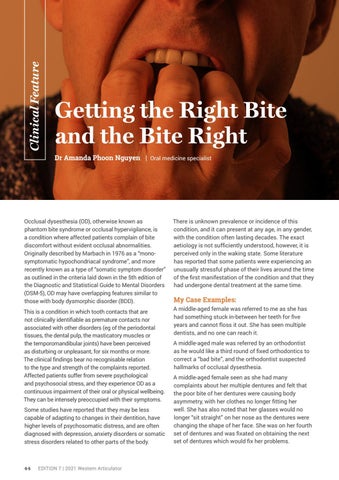Clinical Feature
Getting the Right Bite and the Bite Right Dr Amanda Phoon Nguyen | Oral medicine specialist
Occlusal dysesthesia (OD), otherwise known as phantom bite syndrome or occlusal hypervigilance, is a condition where affected patients complain of bite discomfort without evident occlusal abnormalities. Originally described by Marbach in 1976 as a “monosymptomatic hypochondriacal syndrome”, and more recently known as a type of “somatic symptom disorder” as outlined in the criteria laid down in the 5th edition of the Diagnostic and Statistical Guide to Mental Disorders (DSM-5), OD may have overlapping features similar to those with body dysmorphic disorder (BDD).
There is unknown prevalence or incidence of this condition, and it can present at any age, in any gender, with the condition often lasting decades. The exact aetiology is not sufficiently understood, however, it is perceived only in the waking state. Some literature has reported that some patients were experiencing an unusually stressful phase of their lives around the time of the first manifestation of the condition and that they had undergone dental treatment at the same time.
This is a condition in which tooth contacts that are not clinically identifiable as premature contacts nor associated with other disorders (eg of the periodontal tissues, the dental pulp, the masticatory muscles or the temporomandibular joints) have been perceived as disturbing or unpleasant, for six months or more. The clinical findings bear no recognisable relation to the type and strength of the complaints reported. Affected patients suffer from severe psychological and psychosocial stress, and they experience OD as a continuous impairment of their oral or physical wellbeing. They can be intensely preoccupied with their symptoms.
A middle-aged female was referred to me as she has had something stuck in-between her teeth for five years and cannot floss it out. She has seen multiple dentists, and no one can reach it.
Some studies have reported that they may be less capable of adapting to changes in their dentition, have higher levels of psychosomatic distress, and are often diagnosed with depression, anxiety disorders or somatic stress disorders related to other parts of the body.
44
EDITION 7 | 2021 Western Articulator
My Case Examples:
A middle-aged male was referred by an orthodontist as he would like a third round of fixed orthodontics to correct a “bad bite”, and the orthodontist suspected hallmarks of occlusal dysesthesia. A middle-aged female seen as she had many complaints about her multiple dentures and felt that the poor bite of her dentures were causing body asymmetry, with her clothes no longer fitting her well. She has also noted that her glasses would no longer “sit straight” on her nose as the dentures were changing the shape of her face. She was on her fourth set of dentures and was fixated on obtaining the next set of dentures which would fix her problems.















